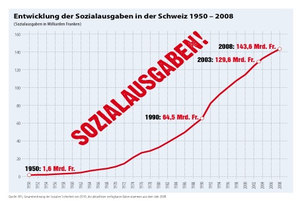
Unternavigation
Swiss People’s Party
The Swiss People’s Party (SVP) advocates right wing, conservative social policy. After aligning their social policy closer to that of the centre parties in the 1970s, the party has been a prominent critic of social security since the 1990s.
Cantonal farmers’ parties united in 1921 to form the Farmers’, Burghers and Craftsmen Party (BGB) and became one of the four largest governing parties. The party won its first seat on the Federal Council in 1929 with Rudolf Minger. Being part of the ‘magic formula’, the BGB has had an informal claim to a seat on the Federal Council since 1959. The BGB represented a conservative worldview. The party's main focus was on agricultural and trade policy. In social policy, it held similar positions to those occupied by the two other bourgeois parties, the CVP and FDP.
In 1971, the BGB merged with the Democratic Parties of Glarus and Graubünden, thereby creating the Swiss People’s Party (SVP). With its programmatic reorientation towards the political centre, the party attempted to appeal to broader swathes of voters beyond its base of farmers and craftsmen. In the 1990s, the SVP developed into a business-oriented, right wing populist party under the influence of the Zurich section and party strategist, national councillor and future federal councillor, Christoph Blocher. SVP campaigns and referenda frequently set the tone of the political agenda, particularly in immigration policy, where the party took a restrictive course. It subsequently gained a larger share of the electorate and grew into the strongest party in the National Council in 2003.
The BGB and SVP both emphasised the principle of individual responsibility in social policy debates, without generally calling social security into question. Both parties upheld a conservative model of the family in which solidarity within the family was paramount. They also supported the three-pillar model in old age provision. The SVP has considered the limits of the welfare state to have been reached since the 1980s with the introduction of old age and survivors’ insurance (1947), disability insurance (1959), compulsory unemployment insurance (1976) and occupational old age provision (1985). It now sought the financial consolidation of social security and no further expansion of social policy in order to limit the burden to the economy.
The SVP has been steering specific welfare state debates since 2000. On the one hand, it held the high proportion of foreign nationals to play a role in the insecure financial situation of social security. On the other, it drew attention to welfare fraud as an urgent problem and has been targeting IV pension recipients (debate on bogus disabilities) since 2000 as well as social welfare recipients since 2010.
The positions held by the SVP on social policy have been an important impact on social policy development in the recent decades. The SVP generally supported most social policy proposals until the ninth AHV revision of 1979. After its shift to right-wing populism, it launched or supported referenda against compulsory health insurance (1994), maternity insurance (1999 and 2004) and the harmonisation of family allowances (2006). Conversely, it has backed all legislative proposals cotaining cost reductions or reduced benefits in the domain of old age and survivors’ insurance, disability insurance and unemployment insurance.
Literatur / Bibliographie / Bibliografia / References: Mazzoleni Oscar (2008), Nationalisme et populisme en Suisse. La radicalisation de la „nouvelle“ UDC, Lausanne; Schweizerische Volkspartei (1990), Sozialstaat Schweiz, Bern; Canonica Alan (2013), Missbrauch und Reform. Dimensionen und Funktionen der Missbrauchsdebatten in der schweizerischen Invalidenversicherung aus historischer Perspektive, Schweizerische Zeitschrift für Soziale Arbeit, 13:12, 24–37; HLS / DHS / DSS: Schweizerische Volkspartei (SVP).
(12/2015)




